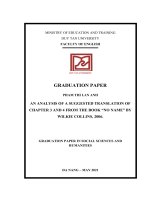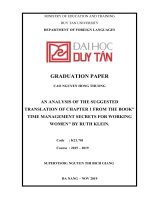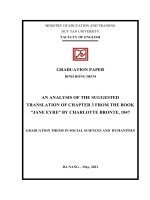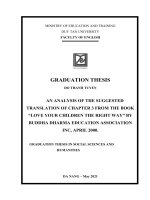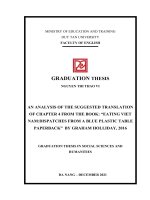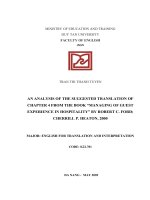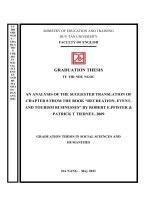AN ANALYSIS OF THE SUGGESTED TRANSLATION OF CHAPTER 2 “AMAZING THAILAND ANOTHER LOOK AT AN EVER CHANGING FOOD CULTURE” FROM THE BOOK “FOOD CULTURE OF SOUTHEAST ASIA PERSPECTIVE OF SOCIAL SCIENCE AND FOOD SC
Bạn đang xem bản rút gọn của tài liệu. Xem và tải ngay bản đầy đủ của tài liệu tại đây (341.63 KB, 76 trang )
GRADUATION PAPER
1
SUPERVISOR : PHAN THI THUY TIEN, M.A
ACKNOWLEDGEMENTS
This graduation paper could not be finished without the invaluable help,
advice, and encouragement of teachers, friends, and relatives. Through this, I would
like to express my thanks. Sincerely to those who have helped me during my study Recent scientific research.
First of all, I would like to express my deepest gratitude to Ms. Phan Thi Thuy
Tien - who directly enthusiastically guided as well as providing the necessary
documents and scientific information for this thesis.
I would like to thank the leadership, the current management board, and all the
teachers of Duy Tan University and the English Department for creating conditions
for me to complete my scientific research.
Finally, I would like to thank my family, relatives, and friends for always
being there for, supporting, and encouraging.
Yours sincerely!
Student
Le Thi Phuong Giang
Student: Le Thi Phuong Giang
24203101825
Code:
GRADUATION PAPER
2
SUPERVISOR : PHAN THI THUY TIEN, M.A
STATEMENT OF AUTHORSHIP
Except for the references included in the text of the thesis, this thesis does
not appear in other publications or is extracted from the standard thesis or
graduation thesis of previous years.
In addition, no other people's works may be used without being properly
acknowledged in the thesis.
Finally, this thesis has not been graded for a diploma or degree in any other
higher education institution.
Danang, May 9th, 2022
LE THI PHUONG GIANG
Student: Le Thi Phuong Giang
24203101825
Code:
GRADUATION PAPER
3
SUPERVISOR : PHAN THI THUY TIEN, M.A
ABSTRACT
This graduation thesis mentions the Vietnamese translation of the report
“Food Culture of Southeast Asia: The perspective of Social Science and Food
Science” compiled by Wahyudi David and Daniel Kofahl (Eds.) with chapter
2 “Amazing Thailand - Another Look at an Ever-Changing Food
Culture". The report is republished in 2021 - a difficult year for the whole
world caused by the covid-19 epidemic. The graduation thesis includes the
theoretical background, the original version, the suggested translation, and the
analysis of many difficult vocabularies and structures in the translation
process. Besides, at the end of the graduation thesis, I also list some
difficulties and offer some solutions for students to better translate.
Student: Le Thi Phuong Giang
24203101825
Code:
GRADUATION PAPER
4
SUPERVISOR : PHAN THI THUY TIEN, M.A
TABLE OF CONTENTS
Student: Le Thi Phuong Giang
24203101825
Code:
GRADUATION PAPER
5
SUPERVISOR : PHAN THI THUY TIEN, M.A
CHAPTER 1. INTRODUCTION
Rationale
1.1.
I am a student majoring in foreign languages, I always have had a
passion to learn about everything from countries around the world and
countries on the same continent. In it, I am always curious about the area
that is always noticed by everyone, which is Southeast Asia along with a
predominantly Buddhist country - the Kingdom of Thailand. With a
curious nature, I found a report on Southeast Asian Culinary Culture
(Perspective of Social Science and Food Science) in general and on Thai
Food Culture in particular.
Southeast Asia consists of 11 countries (Vietnam Thailand
Philippines Malaysia Indonesia Singapore Myanmar Laos Cambodia
East Timor Brunei). Although all 11 countries are located in the same
region, each country has its own unique culture and cuisine that is
unmistakable. Thailand is a country in particular in this region that I
want to explore because: firstly, Thailand is a great tourist destination,
now Thailand not only preserves its inherent traditions, but also the
country. It is also open to new things that make the country more
developed. Second, the pungent taste in Thai dishes is traced back to
when Columbus brought chili peppers to Spain and European countries
in 1493, but they were not used to the strong taste of chili peppers, so he
brought chili peppers to Africa. and Asia, specifically Thailand. Since
then, this country has always considered this ingredient a luxury and
marinated it in their dishes. In addition, shallow spicy, and sweet flavors
are also two main flavors in Thai dishes. Third, the way they eat their
meals is a combination of Asian and European ways of eating,
Student: Le Thi Phuong Giang
24203101825
Code:
GRADUATION PAPER
6
SUPERVISOR : PHAN THI THUY TIEN, M.A
specifically, people use chopsticks, knives, and forks, and eat with their
hands. Fourth, Thai cuisine is also influenced by China, Southeast Asian
countries, and European countries. Finally, the ranking will rank
Thailand's position in diabetes compared to other countries, namely the
United States.
Through this graduation thesis, I hope to be able to study
more about specialized documents on cultures of countries around the
world. Therefore, I have chosen to translate the part “Amazing Thailand
— Another Look at an Ever Changing Food Culture” from the report
“Food Culture of Southeast Asia: The perspective of Social Science and
Food Science” republished by Wahyudi David and Daniel Kofahl (Eds.)
in 2021 so that everyone can have more knowledge and reference about
the culture and cuisine of Southeast Asia in general and Thailand in
particular.
1.2.
1.2.1.
Aims and Objectives
Aims
Through the graduation thesis, I want to aim at the following goals:
•
Helping Vietnamese readers better understand the social culture and
•
cuisine of Southeast Asia in general and Thailand in particular.
Answering everyone's questions and doubts about the historical origin of
•
the social culture and cuisine of this place.
Having a suggested translation for students studying with a major in
•
English for translation and interpretation to read and refer to.
Supporting everyone to improve their skills in the translation process.
Student: Le Thi Phuong Giang
24203101825
Code:
GRADUATION PAPER
7
SUPERVISOR : PHAN THI THUY TIEN, M.A
1.2.2. Objectives
By carrying out this graduation thesis, I have learned lots of
helpful things:
•
Knowing how to apply appropriate words and sentences
to many specific situations by translating the report into
•
Vietnamese.
Gaining a broad knowledge of the terms and concepts of
the socio-cultural and culinary fields through analysis of
•
vocabulary and sentence structure.
Avoid common faults in the process of translation as well
as find out what difficulties translators may face in the
translation process to propose solutions to overcome
those challenges.
Scope of the Study
1.3.
In this graduation thesis, I would like to present a suggested
translation from the source language in English to the target language
in Vietnamese of the part “Amazing Thailand — Another Look at an
Ever Changing Food Culture” from the report “Food Culture of
Southeast Asia: The perspective of Social Science and Food Science”
republished by Wahyudi David and Daniel Kofahl (Eds.) in 2021.
Besides, I want to suggest an analysis of the original version as well as
the difficult words, phrases, and structures.
Text Features
1.3.1.
I would like to choose to translate and analyze the section "
Amazing Thailand — Another Look at an Ever Changing Food Culture "
Student: Le Thi Phuong Giang
24203101825
Code:
GRADUATION PAPER
8
SUPERVISOR : PHAN THI THUY TIEN, M.A
of the report “Food Culture of Southeast Asia: The perspective of Social
Science and Food Science” republished by Wahyudi David and Daniel
Kofahl (Eds.) in 2021. This section introduces the historical origins of
Thai cuisine and the influences of neighboring countries on Thai food
and food customs. as well as detailed explanations of a great Thailand.
This report also outlines the views and proves Thailand's greatness.
1.3.2.
Text Length
The report consists of thirty-eight pages. Due to time constraints, I
have only translated this report into nearly three thousand seven hundred
words. The name of this episode is “Amazing Thailand — Another Look
at an Ever Changing Food Culture”.
1.3.3.
Text Organization
Each chapter of the " Food Culture of Southeast Asia: The
perspective of Social Science and Food Science" report consists of
several subsections. Therefore, I decided to choose the chapter "
Amazing Thailand — Another Look at an Ever Changing Food Culture "
including the following parts: Regional Cuisines, Beginnings and
"Indianization", Where's the Chili ?, Streetfood, International Exchanges,
“Thai Soul" - The Rise of Isan Foodways, Less Rice, and Sugar, Sugar to
translate and analyze.
This graduation thesis consists of six chapters:
Student: Le Thi Phuong Giang
24203101825
Code:
GRADUATION PAPER
9
SUPERVISOR : PHAN THI THUY TIEN, M.A
• Chapter 1 is the introduction of this thesis including rationale, aims,
and objectives, the scope of the study, method of the study, and
organization of the study.
• Chapter 2 is about the theoretical background of translation.
• Chapter 3 is the translated version of the report.
• Chapter 4 is about the analysis of vocabulary and structures of the
suggested translation.
• Chapter 5 shows the difficulties during the translation process and gives
some solutions to deal with the difficulties.
• Chapter 6 gives out conclusions as well as suggestions
1.3.4.
Text Source
The part “Amazing Thailand — Another Look at an Ever
Changing Food Culture” from the report “Food Culture of Southeast
Asia: The perspective of Social Science and Food Science” was
republished by Wahyudi David and Daniel Kofahl (Eds.) in 2021. This
report is available on the internet and can be easily accessed to read and
refer to the following link trenk-amazing_thailand.pdf
1.4.
Method of the Study
Being a student majoring in English, I am well-trained to have
a lot of useful knowledge and experience. This graduate thesis is carried
out to help me improve my vocabulary and structure as well as gain a
general knowledge of translation about culture, society, and cuisine.
Moreover, I have learned a lot of useful and interesting information in
some introductory books or reports on food, society, and culture. I use
Student: Le Thi Phuong Giang
24203101825
Code:
GRADUATION PAPER
M.A
10
SUPERVISOR
: PHAN THI THUY TIEN,
enumeration, quantitative data research, and qualitative data research to
come up with difficult vocabulary and structures. In particular, I received
the enthusiastic support of lecturers and friends to get more necessary
information in the process of making this graduation thesis.
Student: Le Thi Phuong Giang
24203101825
Code:
GRADUATION PAPER
M.A
11
SUPERVISOR
: PHAN THI THUY TIEN,
CHAPTER 2. THEORETICAL BACKGROUND
2.1.
Translation Theory
2.1.1.
Definition
These days there are more and more definitions of translation by
different authors and each of these has its thinking about the translation.
Here are some definitions of translation given by some well-known
linguistic experts:
According to the definition of J. C. Catford in the book “A
Linguistic Theory of Translation”, “Translation is the replacement of
textual material in one language (SL) by equivalent textual material in
another language (TL).” (Catford, 1965)
Besides, from the book “Translation” by Allan Duff, he quoted Dr.
Ian Tudor as declaring that: “Translation, as the process of conveying
mesthe sage across linguistic and cultural barriers, is an eminently
communicative activity, one whose use could well be considered in a
wider range of teaching situations than may currently be the case.”
(Duff, 1989)
Moreover, according to the explanation of Jeremy Munday in the
book “Introducing Translation Studies”, “The process of translation
between two different written languages involves the changing of an
original written text (the source text or ST) in the original verbal
language (the source language or SL) into a written text (the target text
or TT) in a different verbal language (the target language or TL).”
(Munday, 2016)
Student: Le Thi Phuong Giang
24203101825
Code:
GRADUATION PAPER
M.A
12
SUPERVISOR
: PHAN THI THUY TIEN,
In conclusion, in my point of view, translation is the direct
transition between at least two languages: source language (SL) and
target language (TL), based on learned theory and practical experience.
2.1.2 Types of Translation
J. C. Catford presented that: “Translation equivalences may be
set up, and translations performed, between any pair of languages or
dialects - “related” or “unrelated” and with any kind of spatial,
temporal, social or other relationship between them” [1], in the book “A
Linguistic Theory of Translation”. (1965:20)
According to J. C. Catford (1965:20), in the book “A Linguistic
Theory of Translation”, there are many types of translation defined by
many different criteria, such as terms of extent, levels, and the rank of
translation.; then I decided to quote the source from some of the books to
clarify.
2.1.2.1.
Translation According to Extent
Based on the extent, J. C. Catford classified translation into Full
Translation and Partial Translation:
• Full Translation means that all elements of the source language
text are replaced by target language text materials.
For example, “The race ended and ended the hopes too. What
Champions League has is just the name of Chelsea. Manchester City has
been left behind.”
Suggested version: “Cuộc đua đã khép lại, và những hy vọng
cũng chấm dứt. Champions League vẫn chỉ còn mỗi cái tên Chelsea.
Manchester City đã bị bỏ lại phía sau.”
Student: Le Thi Phuong Giang
24203101825
Code:
GRADUATION PAPER
M.A
13
SUPERVISOR
: PHAN THI THUY TIEN,
• Partial translation can be understood as some parts of the source
text that will not be translated, only moved to incorporated in the target
text.
Such as: “How a wonderful place ever!”
And I have a suggested version: “Một nơi thật tuyệt vời!”
2.1.2.2. Translation According to Levels
In terms of levels, translation is divided into two types by J.C.
Catford: Total Translation and Restricted Translation
Total Translation can best be explained as the TL material
replacing all levels of the SL text. Total replacement is involved but it
cannot be replaced by equivalents at all levels; thus, “Total Translation”
is a misleading term.
For instance: “There is nothing permanent except change”.
This sentence will mean in Vietnamese: “Sẽ khơng có gì là mãi
mãi ngoại trừ sự thay đổi”.
Restricted Translation can mean that the equivalent TL textual
material replaces the SL textual material at the same level; whether at the
phonological or graphological el, or at the levels of grammar and lexis.
For example: “I have to take care of my grandparents”
And I have translated version: “Tôi phải quan tâm đến ông bà
của tôi.”
Writing in the book “A Linguistic Theory of Translation”
(1965:22), J. C. Catford deemed that although phonological or
graphological translation can happen, there can be no analogous
Student: Le Thi Phuong Giang
24203101825
Code:
GRADUATION PAPER
M.A
14
SUPERVISOR
: PHAN THI THUY TIEN,
“contextual translation”. However, there is no possibility of replacing
the SL "contextual units" with the equivalent TL "contextual units"
without instantaneously replacing the grammatical or lexical elements.
Therefore, the separability of phonology or graphology for translation
intentions and the circumstances is impossible.
Firstly, in Restricted Translation at Phonological Translation, in
phonological translation, the equivalent TL phonology will replace the
SL phonology, and there is only the replacement of grammatical or
lexical changes.
For example, “Radio”
Suggested version: “Ra-đi-ô”
Secondly, in Restricted Translation at Graphological Translation,
in graphological translation, the equivalent TL graphology will replace
the SL graphology; there are only the again accidental changes without
other replacements.
For instance: “Afghanistan”
Suggested version: “Áp-ga-ni-xtan”
The process of phonological and graphological translation is more
complex, as both must be contained in a general theory of translation.
Besides, Restricted Translation at the grammatical and lexical
levels means the grammar of SL is substituted by the equivalent
grammar in TL; however, lexis is not replaced. There is only the
grammatic is replaced.
Student: Le Thi Phuong Giang
24203101825
Code:
GRADUATION PAPER
M.A
15
SUPERVISOR
: PHAN THI THUY TIEN,
For example: “Cao Lau” is one of the traditional foods of
Vietnam”.
Because “Cao Lau” is a proper noun, there is no need to translate this
word; therefore, I have the suggested version: “Cao Lầu” là một trong
những món ăn truyền thống của Việt Nam.”
2.1.2.3. Translation According to Rank
Based on the rank, J. C. Catford classified translation into Rankbound Translation and Unbounded Translation:
Rank-bound Translation, we can mean that the selection of
equivalent target-language text is limited to only one rank, such as wordfor-word equivalence, morpheme-for-morpheme equivalence, and so on.
Unbounded Translation, we can understand simply that it may
move freely up and down the scale of rank.
For instance: “That sounds like a good deal, but I’d like to sleep
on it before I give you my final decision.”
Suggested translation: “Nghe có vẻ là một thỏa thuận tốt, nhưng
tôi muốn suy nghĩ kĩ trước khi đưa ra quyết định cuối cùng cho bạn.”
(Unbounded Translation – Free Translation)
Or “Nghe có vẻ là một thỏa thuận tốt, nhưng tôi muốn ngủ quên
trước khi đưa ra quyết định cuối cùng cho bạn.” (Rank-bound
Translation – Word-for-word Translation).
Student: Le Thi Phuong Giang
24203101825
Code:
GRADUATION PAPER
M.A
2.2.
16
SUPERVISOR
: PHAN THI THUY TIEN,
Principles and Methods of Translation
2.2.1.
Principles of Translation
Mr. Alan Duff gave some general principles of translation in the
book “Translation” (1989:10). These principles will help the students
well as the translator or translate better.
2.2.1.1.
Meaning
The translation has to accurately reflect the meaning of the
original text. It is not arbitrary to add or remove anything, although
transposing part of the meaning is sometimes possible.
For example: “He looks for his dictionary.”
Translated version: “Anh ấy tìm quyển từ điển của mình.”
2.2.1.2.
Form
Mentioned in the book “Translation” (1989:10), Alan Duff said
that the translation has to ensure that the order of words and ideas should
match as much as possible with the original, especially in the form and
order of words or in translating legal documents, guarantees, contracted,
etc
However, the translators have to change the form and order of the
word based on the difference in the structure of the language.
Example: “Take advantage of changing customer preferences.”
Translated version: “Tận dụng lợi thế của việc thay đổi sở thích
của khách hàng.”
Student: Le Thi Phuong Giang
24203101825
Code:
GRADUATION PAPER
M.A
2.2.1.3.
17
SUPERVISOR
: PHAN THI THUY TIEN,
Register
Languages are often greatly different from their level of formality
in a particular context. Translators must distinguish between formal
expressions and personal expressions in which the writer and speaker
establish the tone to resolve these differences.
For instance: “Please do not park the car here.”
Suggested version: “Xin vui lòng không đỗ xe ở đây.”
2.2.1.4.
Source Language Influence
The translated version sounds unnatural is one of the most regular
criticisms of translating.
This is because the original text has a strong impact on the
mindset of the translator. Ignoring the original text and translating a few
sentences from memory to get a natural mindset in the target language is
the best way to avoid this error.
For example: “My father has a sweet tooth, so he is also
overweight.”
Suggested version: “Ba tôi hảo ngọt nên ông ấy thừa cân.”
2.2.1.5.
Style and Clarity
In general, translators should not change the style of the original
text. But if the original text has many errors such as sloppy, boring, or
repetitive, the translator can correct those faults for the benefit of the
reader.
For example: “She is young, pretty, and well-proportioned.”
Student: Le Thi Phuong Giang
24203101825
Code:
GRADUATION PAPER
M.A
18
SUPERVISOR
: PHAN THI THUY TIEN,
Suggested version: “Cô ấy vừa trẻ, vừa đẹp và có thân hình cân
đối.”
2.2.1.6.
Idioms
Idiomatic expressions include similes, metaphors, proverbs,
sayings, jargon, slang, colloquialisms, and phrasal verbs and it is very
difficult to translate. To resolve this matter, try any of the following:
keeping the original word in quotation marks, maintaining the original
expression, with a literal explanation in brackets, applying an equivalent
word, and using a non-idiomatic or plain prose translation.
Note: The golden rule is that if the idiom does not affect the target
language, do not oblige it into the translation.
I have an example: “You scratch my back and I‟ll scratch
yours.”
And this sentence will be translated: “Có qua có lại mới toại
lòng nhau.”
2.2.2. Methods of Translation
In the book “A textbook of translation” (1989:45), Peter New
Mark mentioned about eight methods of translation.
Translating literally or freely has always been the most significant
element of translation
2.2.2.1.
Word-for-word Translation
Peter Newmark stated in the book “A textbook of translation”
(1989:45) that: This is often demonstrated as interlinear translating with
the TL immediately below the SL words. The SL word order is
preserved, and the words are translated by their most common meanings,
Student: Le Thi Phuong Giang
24203101825
Code:
GRADUATION PAPER
M.A
19
SUPERVISOR
: PHAN THI THUY TIEN,
out of context. Cultural words are translated literally. The main use of
word-for-word translation is either to understand the mechanics of the
SL or to construct a difficult text as a pre-translation process.
Example: “Like is afternoon.”
And suggested version: “Thích thì chiều.”
2.2.2.2.
Literal Translation
The nearest grammatical structures of the equivalent target
language will replace the source language, but the words are translated
individually without the context. This is a pre-translation process, which
points to problems needing to be solved.
For instance: “That book will be published this afternoon.”
Translated version: “Cuốn sách đó sẽ được xuất bản vào chiều nay.”
2.2.2.3.
Faithful Translation
This translation method will try to replicate exactly the
contextual meaning of the original bounded by the target language’s
grammatical structure. It “transfers” cultural words and maintains the
“abnormality” level of grammar and vocabulary (deviation from source
language standards) in the translation.
Faithful translation tries to be completely faithful to the purposes
and realization of the source language text of the writer.
For example: “He is as fat as a pig.”
Suggested version: “Anh ấy mập như một con heo.”
Student: Le Thi Phuong Giang
24203101825
Code:
GRADUATION PAPER
M.A
2.2.2.4.
20
SUPERVISOR
: PHAN THI THUY TIEN,
Semantic Translation
Semantic Translation is quite similar to the Faithful Translation,
but it is different in that it has to keep the aesthetic value of the source
text more, in addition, have to compromise the appropriate "meaning" so
that there is no use assonance, word-play, or repetition jars in the
completed translation.
“Further, it may translate less important cultural words by the
culturally neutral third or functional terms but not by cultural
equivalents.”
The key difference is that Faithful Translation is rigorous and
dogmatic, while Semantic Translation is more flexible and creative as
well as allows the translator to associate with the original text.
I show an example to show this method: “Ten European Union
countries on Friday expressed regret at the U.S. plans to withdraw from
the Open Skies treaty and vowed to uphold the pact, as NATO envoys
met to discuss developments.”
Suggested version: “Thứ 6 vừa qua, mười quốc gia thuộc Liên
minh châu Âu đã bày tỏ sư tiếc nuối về kế hoạch rút khỏi Hiệp ước Bầu
trời của Mỹ và đã cam kết sẽ duy trì hiệp ước, khi các phái viên NATO
đã gặp nhau để thảo luận về các diễn biến tiếp theo.”
2.2.2.5.
Adaptation Translation
This is the “freest” translation method, used mainly for plays and
poetry as well as music and movies. The themes, characters, and plots
are usually kept; in addition, the source language culture is converted to
the target language and the text will be rewritten.
Student: Le Thi Phuong Giang
24203101825
Code:
GRADUATION PAPER
M.A
21
SUPERVISOR
: PHAN THI THUY TIEN,
For example:
“Boscombe Valley is a country district not very far from Ross, in
Herefordshire. The largest landed proprietor in that part is a Mr. John
Turner, who made his money in Australia and returned some years ago
to the old country. One of the farms which he held that of Hatherley was
let to Mr.Charles McCarthy, who was also an ex-Australian.”
(Conan Doyle, The Boscombe Valley Mystery, The
Adventures of Sherlock Holmes)
Suggested version:
“Thung lũng Boscombe là vùng nông thôn gần thị trấn Ross,
thuộc miền Herefordshire. Một chủ đồn điền lớn nhất vùng ở vùng ấy là
ngài John Turner. Ông ta đã làm giàu bên Áo và vài năm trước đây đã
trở về tổ quốc. Ông ta cho ngài Charles McCarthy thuê một trang trại
của mình, trang trại Hatherley - người này trước kia cũng sống ở bên
Áo.”
(Nhà văn Conan Doyle, Bí ẩn tại thung lũng Boscombe,
Những cuộc phiêu lưu của Sherlock Holmes)
2.2.2.6.
Free Translation
“Free translation reproduces the matter without the manner or the
content without the form of the original. Usually, it is a paraphrase
much longer than the original, a so-called “intra-lingual translation”,
often prolix, pretentious, and seemingly non- translated at all.”
Such as: “Many of us this summer will fly off on holiday for a
well-deserved break.”
Student: Le Thi Phuong Giang
24203101825
Code:
GRADUATION PAPER
M.A
22
SUPERVISOR
: PHAN THI THUY TIEN,
Suggested version: “Mùa hè này, nhiều người trong chúng ta sẽ
chọn đi du lịch bằng đường hàng khơng để tận hưởng một kì nghỉ xứng
đáng.”
2.2.2.7.
Idiomatic Translation
Idiomatic translation mimics the “message” of the original but
often distorts nuances of meaning by favoring colloquialisms and idioms
that do not exist in the original.
For example: “Neck or nothing.”
And we have a suggested version: “Không vào hang cọp sao bắt
được cọp con.”
2.2.2.8.
Communicative Translation
Communicative Translation strives to provide the most accurate
meaning of the original context in a way that both content and language
are easily accessible and understandable to readers.
For instance: “I cherish you like nothing else!”
And we have a suggested version: “Tôi yêu bạn!”
Student: Le Thi Phuong Giang
24203101825
Code:
GRADUATION PAPER
M.A
23
SUPERVISOR
: PHAN THI THUY TIEN,
CHAPTER 3. SUGGESTED TRANSLATION
3.1. Original Version
3.2. Suggested Version
Food Culture of Southeast Asia:
Văn hóa ẩm thực Đơng Nam Á:
The perspective of Social Science Góc nhìn khoa học xã hội và
and Food Science
khoa học ẩm thực
Chapter 2
Amazing Thailand — Another Look
at an Ever-Changing Food
Culture
[P1] The Thai tourism authority
promotes the country as “Amazing
Thailand”, and this slogan would
repeatedly spring to mind as I traveled
the country conducting field research.
[P2] To me the openness to the new
seemed quite amazing, the openness to
new culinary influences in particular.
[P3] According to the impression of
many, Thais tend to approach the
foreign in the playful adoption of
influences and the creation of
something inimitably unique, above all,
concerning foreign food and cuisine.
[P4] Exemplary of this remarkable
achievement are the way the country
has approached the chili pepper and its
table manners.
[P5] Thai cuisine is famed for its
spiciness, and the chili (prik) has been
adopted as the country's culinary
emblem.
[P6] When Columbus first brought the
chili to Spain in 1493, he advertised it
as a kind of "new pepper," hence
Student: Le Thi Phuong Giang
24203101825
Chương 2
Thái Lan tuyệt vời- Một cái
nhìn khác về một nền văn hố
ẩm thực khơng ngừng đổi thay
[P1] Cơ quan du lịch Thái Lan
quảng bá đất nước là “Thái Lan
tuyệt vời”, và khẩu hiệu này sẽ
liên tục xuất hiện trong tâm trí khi
tơi đi du lịch khắp đất nước tiến
hành nghiên cứu thực địa.
[P2] Đối với tôi, sự cởi mở với
những điều mới dường như khá
tuyệt vời, đặc biệt là sự cởi mở
đối với những ảnh hưởng ẩm thực
mới nói riêng.
[P3] Theo ấn tượng của nhiều
người, người Thái có xu hướng
tiếp cận với nước ngồi bằng cách
tiếp nhận những ảnh hưởng một
cách vui vẻ và tạo ra vài thứ độc
đáo không thể bắt chước, hơn hết
là đối với các món ăn và ẩm thực
nước ngồi.
[P4] Điển hình về thành tích đáng
chú ý này là cách đất nước tiếp
cận với ớt và thái độ trên bàn ăn
của họ.
[P5] Ẩm thực Thái Lan nổi tiếng
với độ cay của nó, và ớt (prik) đã
được chấp nhận như là biểu tượng
ẩm thực của đất nước.
[P6] Khi Columbus lần đầu tiên
mang ớt đến Tây Ban Nha vào
năm 1493, ông đã quảng cáo nó
Code:
GRADUATION PAPER
M.A
24
SUPERVISOR
: PHAN THI THUY TIEN,
initiating an enduring terminological như một loại " ớt mới", do đó bắt
confusion throughout the world.
đầu một sự nhầm lẫn thuật ngữ
lâu dài trên toàn thế giới.
[P7] Europe, however, was at a loss [P7] Tuy nhiên, châu Âu vẫn chưa
about what to do with the unfamiliar tìm được cách dùng ớt với vị cay
pungent quality of the chili and simply nồng vốn dĩ xa lạ nên đã chuyển
passed it on to Africa and Asia.
nó sang châu Phi và châu Á.
[P8] It was only there that Columbus' [P8] Chỉ đến đó, hy vọng của
hope would bear fruit, namely, that Columbus mới đơm hoa kết trái,
people not only accept the chili as a cụ thể là mọi người không chỉ
new kind of pepper but even consider it chấp nhận ớt như một loại ớt mới
the superior variety thereof.
mà thậm chí cịn coi nó là giống
siêu hạng của nó.
[P9] The Thais even went on to [P9] Người Thái thậm chí cịn tiếp
consummate this change in their tục hài lịng với sự thay đổi này
language.
trong ngơn ngữ của họ.
[P10] Initially chili was designated as [P10] Ban đầu ớt được gọi là prik
prik thet or foreign pepper, chili thet hoặc ớt ngoại, ớt ngày nay
nowadays is simply referred to as prik, được gọi đơn giản là prik, trong
whereas the long-established pepper khi loại ớt cũ hơn được gọi là prik
has come to be called prik thai.
thai.
[P11] Hence, rather than seeing in the [P11] Do đó, thay vì nhìn thấy
New World chili the pepper from ở Tân Thế giới ớt hạt tiêu từ các
foreign lands (as has been the fate of vùng đất nước ngoài (như số phận
the tomato, called makuea thet, the của cà chua, được gọi là makuea
"foreign eggplant"), the Thais declared thet, "cà tím nước ngồi"), người
their pepper to be "Thai chili" — which Thái tuyên bố ớt của họ là "ớt
is how one would translate prik thai Thái" - đó là cách người ta sẽ dịch
today.
prik thai ngày nay.
[P12] The country's table manners [P12] Những cử chỉ trên bàn của
amaze and, occasionally, even confuse đất nước này khiến du khách kinh
its visitors, too.
ngạc và thậm chí, đơi khi khiến du
khách bối rối.
[P13] One-way cultures distinguish [P13] Một cách phân biệt các nền
themselves is by way of their table văn hóa đất nước đó chính là
manners.
thơng qua cách cư xử trên bàn ăn
của họ.
[P14] The world's great civilizations [P14] Các nền văn minh vĩ đại
may be grouped according to specific của thế giới có thể được nhóm lại
eating habits.
theo thói quen ăn uống cụ thể.
Student: Le Thi Phuong Giang
24203101825
Code:
GRADUATION PAPER
M.A
25
SUPERVISOR
[P15] In East Asia, it is customary to
eat with chopsticks, whereas in South
Asia one eats with the hand as is true
of much of the Islamic world and all of
Africa.
[P16] The West, by contrast, is
distinguished by the custom of eating
with a knife and fork.
[P17] Thailand, however, is probably
the only food culture, which practices
all three fundamental eating customs.
[P18] Chopsticks are considered
indispensable when eating certain
dishes of Chinese origin, like noodle
soup.
[P19] Since the endeavors of "Siwilai"
in the early twentieth century, whereby
the Thais sought to persuade the
colonial powers that they were already
"civilized", the spoon and fork have
come to dominate the Thai table.
[P20] Thus, the Thais also adopted
Western table manners, although the
knife was felt to be superfluous and
dispensed with.
[P21] However, especially in the
Northeastern provinces, inhabited by a
third of the country's population, the
preferred way to dine is still seated on
mats placed on the floor and using the
hand, it is this ancient etiquette that has
since reappeared in some Bangkok
restaurants.
[P22] Thus, Thailand has adopted and
indigenized new table manners (be
they from the West or China) without
Student: Le Thi Phuong Giang
24203101825
: PHAN THI THUY TIEN,
[P15] Ở Đông Á, người ta thường
ăn bằng đũa, trong khi ở Nam Á,
người ta ăn bằng tay như đúng với
phần lớn thế giới Hồi giáo và toàn
bộ châu Phi.
[P16] Ngược lại, phương Tây
được phân biệt bởi phong tục ăn
bằng dao và nĩa.
[P17] Tuy nhiên, Thái Lan có lẽ là
nền văn hóa ẩm thực duy nhất
thực hiện cả ba phong tục ăn uống
cơ bản.
[P18] Đũa được coi là khơng thể
thiếu khi ăn một số món ăn có
nguồn gốc từ Trung Quốc, chẳng
hạn như phở.
[P19] Kể từ những nỗ lực của
"Siwilai" vào đầu thế kỷ XX, theo
đó người Thái tìm cách thuyết
phục các cường quốc thuộc địa
rằng họ đã là "văn minh", thìa và
nĩa đã chiếm ưu thế trên bàn ăn
của người Thái.
[P20] Vì vậy, người Thái cũng áp
dụng những cử chỉ trên bàn ăn của
phương Tây, mặc dù con dao được
cho là thừa và không cần dùng
đến.
[P21] Tuy nhiên, đặc biệt là ở các
tỉnh Đông Bắc, nơi sinh sống của
một phần ba dân số của đất nước,
cách ăn ưa chuộng vẫn là ngồi
trên chiếu trải trên sàn nhà và sử
dụng tay, đó là nghi thức cổ
xưa đã xuất hiện trở lại trong một
số nhà hàng Bangkok.
[P22] Do đó, Thái Lan đã áp dụng
và làm quen với những cách cư xử
mới trên bàn ăn (có thể là từ
Code:

